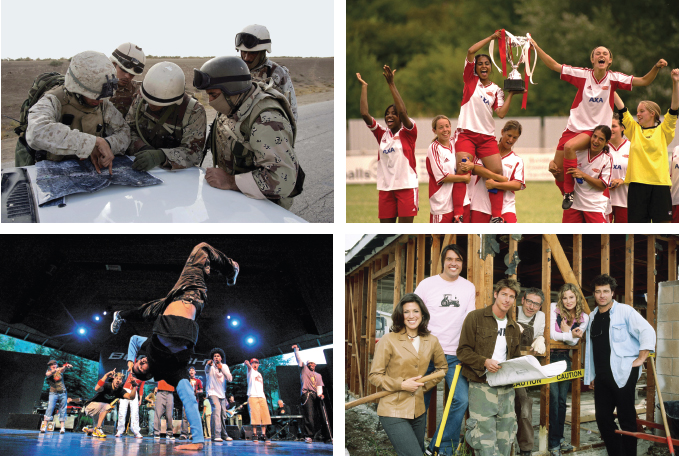Types of Groups
Groups can take many forms. The most common among them are called primary groups—long-lasting groups that form around the relationships that mean the most to their members. Your family constitutes one primary group to which you belong; your friends are another.
In addition to primary groups, there are groups defined by their specific functions (for instance, support groups, study groups, and social groups). However, any one of these groups can perform multiple functions. Alcoholics Anonymous (AA), for example, is primarily a support group—a set of individuals who come together to address personal problems while benefiting from the support of others with similar issues. But AA is also a social group, as membership in the group offers opportunities to form relationships with others. And finally, as a group with a specific mission—to help members manage their struggles with alcohol and addiction—AA is also a problem-solving group.
Although all groups are to some degree social, some groups are more task-oriented than others. Study groups, for example, are formed for the specific purpose of helping students prepare for exams. Perhaps the most task-oriented and goal-driven type of group is the team—a group that works together to carry out a project or to compete against other teams. Sports teams are an obvious example, but teams are also common in large organizations or as subsets of other groups: an Army unit might select a few members to form a reconnaissance team; a community group might nominate a team of individuals to take charge of its annual fund-raiser.
One of the more noteworthy and common types of teams in today’s organizations is the self-directed work team (SDWT), a group of skilled workers who take responsibility themselves for producing high-quality finished work (Colvin, 2012; Douglas, 2002). In self-directed work teams, members control their own management functions, such as arranging their schedules, buying equipment, and setting standards for productivity, quality, and costs. They also conduct their own peer evaluations and coordinate their future plans with management. Their complementary skills and experiences enable the team to accomplish more together than any individual member could achieve independently (Katzenbach & Smith, 1993).

GROUPS COME in all shapes and sizes. Although the design team from Extreme Makeover: Home Edition and a hip-hop dance crew might vary in size and purpose, both are considered groups. (top left) David Furst/AFP/Getty Images; (top right) © 20th Century Fox Film Corp. All rights reserved. Courtesy Everett Collection; (bottom left) AP Photo/Vail Daily, Shane Macomber; (bottom right) ABC/Photofest
Perhaps the most dramatic impact of self-directed teams is the improved performance and cooperation of employees throughout the organization. Organizations are shifting their structural power and decision making from upper levels to lower levels of management in efforts to implement change and growth and empower employees (Douglas, Martin, & Krapels, 2006). Federal Express and Minnesota-based 3M are among an increasing number of companies that involve employees through work teams. (See Table 9.1 for tips on working in a self-directed work team.).
Table : TABLE 9.1 SELF-DIRECTED WORK TEAMS: TIPS FOR WORKING COLLABORATIVELY
| Action |
Considerations |
| Define a clear purpose for the team |
What are the team’s goals—short term and long term? |
| Foster team spirit |
Build a sense of energy, excitement, and commitment in your team by engaging in team-building activities and events, rewarding members who demonstrate commitment, and identifying new challenges for the team to take on. |
| Train |
Working on a self-directed team may be a new experience for some members. See if your organization can provide training to help members understand and implement the defining practices of self-directed teams. |
| Clarify expectations |
Make sure all members of the team understand what’s expected of them in terms of their roles and performance. For example, what functions will each member serve? How, specifically, will the team define “success”? |
| Set boundaries |
Articulate where the team’s responsibilities begin and end. If necessary, remind members that they are working in the service of the organization and that they need to stay focused on their specific purpose. |
Sources: Capozzoli (2002); Nelson (2002); Rosenthal (2001).
[Click here to open Table 9.1 in a supplemental window]
AND YOU?
Question
In your first job out of college, do you think you would prefer to work as part of a self-directed work team or in a more traditionally arranged team where a manager takes control? What would be the advantages of each?
In your first job out of college, do you think you would prefer to work as part of a self-directed work team or in a more traditionally arranged team where a manager takes control? What would be the advantages of each?
